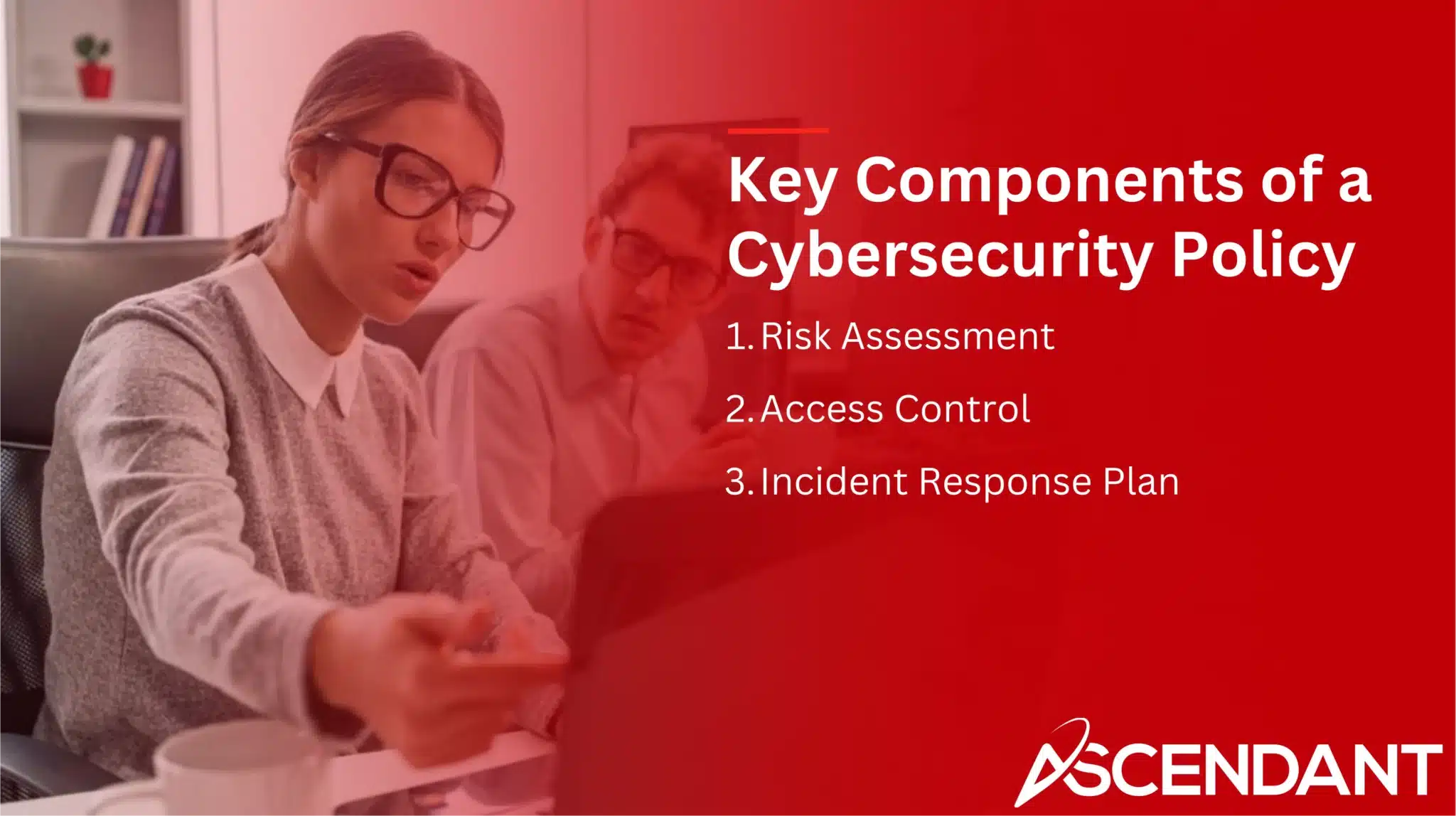Looking to secure your business from cyber threats? This article covers the crucial cybersecurity policies you must implement to protect your systems, data, and reputation. By the end, you’ll know the key elements that make your cybersecurity measures robust and effective.
Key Takeaways
- Cybersecurity policies are essential for protecting organizations against digital threats, serving as both technical necessities and strategic assets that ensure compliance and operational integrity.
- Key components of effective cybersecurity policies include risk assessments, access control, and incident response plans to proactively identify threats and manage potential cyber-attacks.
- Regular employee training and awareness initiatives are crucial to reducing human errors that lead to security breaches, fostering a culture of cybersecurity across the organization.
Understanding Cybersecurity Policies
The cornerstone of an organization’s security against cyber threats lies in robust cyber security policies. These essential documents comprise rules and practices that dictate how to safeguard networks, systems, and data from various forms of cyber-attacks. A sound cybersecurity policy serves as a blueprint for implementing protective measures across the network environment to thwart different types of digital risks while also securing sensitive information, ensuring IT activities align with established standards, maintaining system integrity, and preserving the institution’s esteemed reputation.
Not only are these cybersecurity guidelines imperative for technical protection, but they also function as strategic tools within the organizational framework. An adeptly crafted security policy can be instrumental in mitigating financial damages which may stem from staff oversight – potential costs that could spiral into millions. By bolstering defenses around a corporation’s network infrastructure through clear directives on handling electronic dangers effectively, such policies play a crucial role not just in enhancing safety but also assuring adherence to regulations concerning compliance.
Modern enterprises grapple with updating their security strategies sufficiently due to the rapidly advancing technological landscape paired with escalating capabilities among those intent on committing online crimes. All this compounded by rigorous demands set forth by both federal bodies engaged in homeland defense matters and regulatory protocols aimed at tightly controlling access points without hampering workforce productivity.
In today’s context where cyber-attacks grow more sophisticated incessantly, fostering resilient cybersecurity principles becomes ever more vital for organizations aiming to protect their virtual resources whilst navigating complex compliance mandates actively. It is critical that our methods surrounding the development and enforcement of these important protections evolve alongside rising online challenges so we maintain our stance ahead of emerging threats.
Key Components of a Cybersecurity Policy
A cybersecurity policy is only as strong as its individual components. These policies should embody core attributes such as confidentiality, integrity, availability, authenticity, accountability, non-repudiation, reliability, and critical systems. They should encompass comprehensive security processes throughout the organization and include tailored risk assessments.
Utilizing frameworks like CMMC, NIST, and COBIT can guide the development of thorough and compliant policies. Additionally, implementing an Information Security Program that focuses on people, systems, and tools is essential for managing confidentiality, integrity, and availability.
Risk Assessment
Undertaking a risk assessment is an essential component of crafting a sound cybersecurity strategy. Its main goal is to uncover and catalog threats and weaknesses while ranking the associated risks accordingly. Such assessments are instrumental in spotting potential security issues including data leaks, illicit system access, malware infections, and phishing attempts. With this information at hand, entities can take precise actions aimed at reducing these dangers to bolster their overall protective measures.
It’s imperative for organizations to keep their risk evaluations current in order to pinpoint fresh hazards that surface over time due to the ever-changing nature of cyber threats as well as internal system vulnerabilities. Continually refreshing this assessment guarantees that cybersecurity policies stay pertinent and potent when it comes to neutralizing both existing and nascent cyber threats. Adopting this vigilant stance plays a crucial role in fortifying defenses against cybersecurity incidents.
Access Control
An access control policy is an essential element of any cybersecurity strategy, tasked with ensuring that sensitive data can only be accessed by authorized personnel. It employs rights management strategies to assign user permissions based on specific roles within the organization, effectively reducing the risk of unauthorized access and consequent breaches. A sound access control framework safeguards critical data while upholding the integrity of organizational systems.
In cloud security contexts, stringent measures for controlling who has permission to retrieve sensitive information are imperative. The adoption of multi-factor authentication alongside other technical controls greatly strengthens these security defenses. With a comprehensive approach to managing and monitoring system accesses, organizations bolster their defense against threats aiming to compromise IT assets and maintain strict confidentiality over private information.
Incident Response Plan
Effective management of potential cyber attacks necessitates a robust incident response plan, which is essential in safeguarding digital assets and maintaining an organization’s reputation. Such plans are designed to mitigate or even prevent the effects of cyber attacks through swift, consistent responses tailored to various scenarios, ensuring that security measures are executed quickly and efficiently.
The elements of a comprehensive incident response plan should include clear directions for implementing best practices pertaining to backups, identity verification processes, access controls mechanisms, as well as strategies for rectifying vulnerabilities. To maintain its efficiency and applicability in changing threat landscapes, it’s critical that this plan undergoes routine reviews and updates every six months to one year.
Organizations equipped with a carefully crafted incident response plan are better positioned to handle cyber incidents with agility and effectiveness—thereby reducing the extent of damage inflicted and shortening the duration necessary for recovery.
Types of Cybersecurity Policies
Organizations employ various forms of cybersecurity policies tailored to safeguard different aspects of their security posture. These strategies are differentiated by scope, such as organizational-wide policies, system-specific guidelines, and issue-oriented frameworks.
Among the range of cyber defense measures an organization might put into effect are critical protocols like Network Security Policy, Endpoint Security Policy, and Cloud Security Policy. Regardless of their complexity or breadth, these foundational documents play a pivotal role in securing IT assets and adhering to regulatory standards.
Network Security Policy
Defending against cyber threats is a critical aspect of network security, which aims to safeguard data within networks from being compromised. Employing tools such as Intrusion Detection Systems (IDS) are pivotal in detecting and mitigating cyber attacks. Reinforcing the defense mechanism with firewalls configured with robust security rules significantly fortifies network protection.
Segmentation of the network plays a significant role in bolstering security by confining access rights exclusively to verified users. A thorough set of cybersecurity guidelines should cover diverse elements that include but are not limited to access management, strategies for responding to incidents, and encrypting data.
By merging Identity and Access Management (IAM) solutions into the existing framework for network safety, additional layers of protection can be achieved. This ensures stringent control over who gains entry to sensitive information thereby enhancing overall system integrity.
Endpoint Security Policy
Allowing the use of personal devices within an organization can elevate the potential for security breaches. As such, it is imperative that companies adopt a robust Bring Your Own Device (BYOD) Security Policy when their employees are permitted to utilize their own gadgets in a work context. To enhance the strength of this policy, integrating context-aware security mechanisms is crucial as they govern and fortify the defense systems of these personal apparatuses against becoming vulnerable points within an entity’s cybersecurity shield.
To ward off cyber threats effectively and preserve confidential data from unauthorized access or exposure, setting up endpoints like laptops and smartphones with secure configurations is indispensable. The critical elements necessary in securing these devices comprise:
- Registering each device
- Restrictive measures on software installations
- Routine updates enforcement
- Robust protection strategies implementation
- Encryption protocols for stored data
- Controlled network connectivity
By attending meticulously to these aspects regarding endpoint device management, organizations not only protect vital information, but also reinforce their overall stature in terms of digital safety and resilience against various types of cybersecurity risks.
Cloud Security Policy
The susceptibility of cloud-based systems to cyber attacks is notably higher than that of other systems, placing them at increased risk. It’s advisable for organizations operating in the cloud to bolster their security by implementing multi-factor authentication as it adds an additional safeguard ensuring only properly authenticated users gain entry to these digital resources. Leveraging a Cloud Access Security Broker (CASB) can extend the organization’s security policies’ effectiveness, offering robust protection for assets hosted on the cloud.
Beyond just relying on multi-factor authentication and CASBs, entities must take into account supplementary protective measures including data encryption and conducting periodic security evaluations. By confronting the specific hurdles associated with securing cloud platforms, businesses are better positioned to defend their valuable digital assets against compromise and maintain comprehensive integrity across their cloud infrastructures.
How to Develop Effective Cybersecurity Policies
Crafting a robust cybersecurity policy is an intricate process that encompasses several critical steps. It necessitates the collaboration of a diverse group from various disciplines such as IT, legal departments, human resources, and executive management to address all facets of the company’s security demands comprehensively.
Commencing with the establishment of clear goals and boundaries is essential so that the cybersecurity strategy aligns seamlessly with the broader business aims. To actualize this strategy effectively, it is crucial to deploy tools and technologies specifically tailored for upholding these policies. Engaging seasoned professionals specializing in cybersecurity can greatly contribute to formulating solid security protocols.
Define Objectives and Scope
It is vital for organizations to tailor their cybersecurity policy so that it supports and advances the overall goals of the business. Structuring a thorough cybersecurity policy requires careful analysis of both the demands of the enterprise and potential threats in its environment. With attainable goals set step by step, an organization can forge robust cybersecurity policies tailored to meet distinct security needs.
Defining a comprehensive scope for a cybersecurity policy necessitates factoring in various internal and external influences. Organizations must have clarity on the unique risks they confront along with how these might affect daily operations within their business framework. An exhaustive evaluation of these elements ensures that organizations devise relevant and potent strategies within their cybersecurity policies to tackle such risks effectively.
Establish Security Guidelines
Organizations ought to establish thorough security policies regarding BYOD (Bring Your Own Device) to counteract the risks associated with personal devices. It’s vital that employees are granted access to key documents, which include password management, guidelines for acceptable use, and protocols for remote access. Such documentation offers explicit directions on securing both personal and organizational IT assets.
Undertaking a detailed assessment of potential threats is instrumental in prioritizing protective measures accordingly. Crafting extensive security procedures is essential in controlling IT assets while bolstering operational effectiveness within an organization. The protection of sensitive information can be ensured by enacting well-defined rules and procedures that support a robust security framework.
Train Employees
Consistent instruction equips employees with the skills to identify and respond appropriately to cybersecurity threats, which is essential in cultivating an environment where awareness of cybersecurity is ingrained among staff members. Sustained educational efforts ensure that organizational protocols for managing cyber risks are both well-understood and properly executed by all team members. As a consequence, organizations can drastically cut down on the likelihood of security breaches originating from human mistakes through a firm commitment to training their workforce.
It’s important for organizations not just to conduct periodic training, but also sustain employee engagement with up-to-date information about emerging cyber dangers and effective countermeasures. This might entail providing seminars, interactive webinars, or granting unrestricted access to current online instructional content.
Allocating resources towards the continuous education of its personnel allows an organization to foster a culture proficient in addressing various aspects of cybersecurity. Such strategic investment inevitably results in creating an empowered body of workers adept at confronting digital security challenges head-on.
Ensuring Compliance with Cybersecurity Regulations
Organizations must tailor their cybersecurity policies to be in harmony with both local and international regulatory compliance mandates. To shield organizations from legal exposures, compliance frameworks recommend the implementation of robust cybersecurity strategies. Through adherence to pertinent statutes and guidelines, firms can reduce legal vulnerabilities and circumvent possible fines. It is imperative that any strategy for patching and maintenance corresponds with legislative standards like those outlined by HIPAA or GDPR.
Crafting a well-articulated cybersecurity policy is vital for organizations aiming to fulfill an array of statutory and regulatory obligations tied to digital assets protection. This necessitates a comprehensive grasp of relevant compliance demands specific to the organization’s operations while ensuring that these demands are thoroughly integrated into their cybersecurity measures. Remaining vigilant about shifts in regulations and modifying policies as necessary permits companies not only to persist in compliant status, but also fortifies safeguards around their digital resources.
Best Practices for Maintaining Cybersecurity Policies
It is critical to continuously revise cybersecurity policies in order to tackle new threats and adapt to the ever-changing needs of business environments. Simulating cyberattacks allows for testing the robustness of a cybersecurity policy, revealing potential frailties that can then be fortified. Consistently reviewing an incident response plan guarantees its ongoing effectiveness and alignment with current circumstances.
Maintaining open lines of communication regarding prevailing cyber trends and associated dangers is vital for organizations aiming to bolster their protective measures. When stakeholders are well-informed about cybersecurity matters, they become more cognizant of their individual responsibilities within the framework of organizational security.
Frequent reviews and updates to cybersecurity strategies, coupled with thorough risk assessments, empower organizations against emerging risks by preemptively addressing vulnerabilities before they can be exploited by adversaries.
The Role of Employee Education and Awareness
Security breaches often occur due to human error, with a staggering 95% of such incidents arising from these blunders. By routinely training employees, an understanding of cybersecurity threats is cultivated as well as their crucial role in minimizing those risks. Businesses can notably decrease the incidence of successful cyber crimes when they instill regular security awareness programs that bolster cyber hygiene throughout the firm.
Encouraging employee participation in security practices fosters an organizational culture steeped in safety consciousness. Providing effective education enhances staff assurance when dealing with cybersecurity issues. If ongoing instruction is neglected, businesses face higher probabilities of data violations and potential tarnishing of their public image. Hence, prioritizing investments into workforce training and vigilance serves as a vital component for sustaining robust defense against cyber threats.
Leveraging Cybersecurity Services
Professional cybersecurity services are essential for crafting and upholding stringent cybersecurity policies that adhere to industry compliance standards. Firms such as Sprinto provide organizations with ready-made policy templates designed to maintain alignment with these standards. These services enable employees within an organization to readily access, review, and affirm updates to policies, which bolsters ongoing awareness and adherence to compliance.
Organizations can capitalize on the specialized knowledge and assistance offered by cybersecurity services in overseeing their specific security needs. Such support is invaluable for pinpointing weak spots within their systems, executing robust security strategies, and ensuring consistent conformity with legislative demands regarding security measures.
In an environment where cyber threats continuously evolve, forming alliances with professional cybersecurity providers equips organizations with the necessary expertise and tools required to safeguard their digital assets from potential risks effectively.
Summary
In summary, the establishment of strong cybersecurity strategies is vital to defend organizations against cyber threats and maintain adherence to legal standards. Organizations can create detailed cybersecurity policies tailored to their unique security requirements through evaluating risks, implementing measures for access control, and devising protocols for incident response. Continually updating these policies and training employees are fundamental actions in preserving their efficacy.
Investing in professional cybersecurity services coupled with cultivating a culture that prioritizes security consciousness among staff members can significantly strengthen an organization’s stance on cybersecurity. By adhering to the recommended guidelines and adopting exemplary practices highlighted within this manual, companies are positioned well to construct a solid strategy focused on protecting digital assets against cyber threats while simultaneously ensuring sustainable prosperity.
 Frequently Asked Questions
Frequently Asked Questions
What are the key components of a cybersecurity policy?
The key components of a cybersecurity policy are risk assessment, access control, and an incident response plan. These elements collectively enable organizations to identify risks, safeguard sensitive data, and manage cyber incidents effectively.
How often should a risk assessment be updated?
A risk assessment should be updated regularly to identify and address new and emerging threats effectively. This practice ensures that the cybersecurity policy remains relevant and proactive.
Why is employee training important in cybersecurity?
Educating employees on how to identify threats and adhere to security protocols is crucial in cybersecurity, as it reduces the risk of breaches stemming from human mistakes. When organizations invest in training their staff, they substantially improve their overall stance on security.
What is the role of professional cybersecurity services?
Cybersecurity services play a critical role for organizations by helping them establish and uphold extensive cybersecurity measures, spotting security weaknesses, and upholding adherence to regulatory standards.
Utilizing these professional services is crucial in protecting sensitive data and improving the general security framework of an organization.
How can organizations ensure compliance with cybersecurity regulations?
Organizations can ensure compliance with cybersecurity regulations by aligning their policies with relevant legal requirements and conducting regular audits. Staying informed about regulatory changes and adhering to standards such as HIPAA and GDPR is essential for maintaining compliance.



